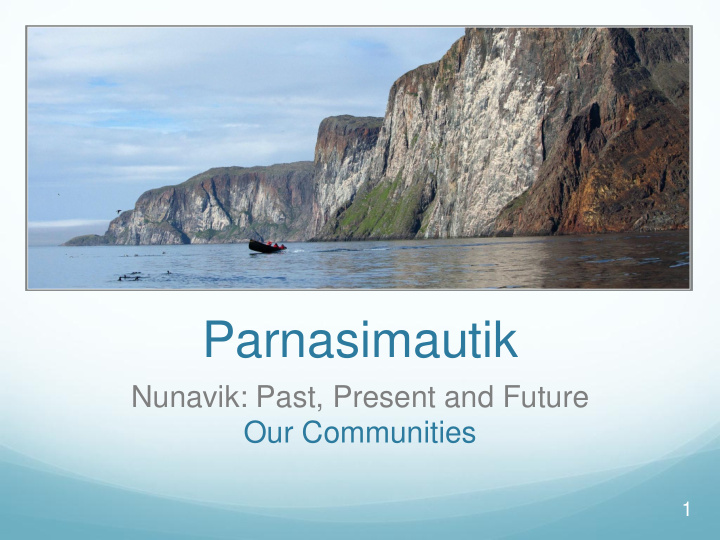



Parnasimautik Nunavik: Past, Present and Future Our Communities 1
Elders, Women and Youth (Sector 5) Service improvements are needed for elders, and elders must also be enabled to make meaningful contributions to their communities. As the main caretakers of Inuit families, women are concerned with issues such as health, healing, culture and language, as well as community and industrial development. Healthy environments for youth start in decent homes with adequate nutrition and involve investments in programs. Youth must be encouraged to play active roles in their communities. 2
Education (Sector 6) The KSB promotes Inuit culture, language and identity in its curriculum and pedagogical materials. Inuit students must have access to the same services and pathways as those in the south. 3
Education (continued) Proper funding for educational program development and training is needed. A full-time Bachelor of Education training program for Inuit teachers must be more accessible in order to speed up certification. College education must be made available in Nunavik. 4
Health (Sector 7) Major advances in the delivery of healthcare in the region since 1975 have improved the general well-being of residents. 5
Health (continued) A shortage of Inuit staff makes it difficult to deliver healthcare in line with Inuit values. The recruitment and retention of healthcare professionals is difficult. Continued improvements in the well-being of our communities depends on solutions to the region’s social problems. 6
Housing (Sector 8) In recent years, new housing construction has failed to meet increasing demand. Overcrowding is a serious problem. Overcrowded housing impacts negatively on the health of Nunavimmiut and can foster contagious diseases. Homeownership could help alleviate the housing shortage. Despite government programs, the high costs of construction and municipal taxes and the high cost of living are obstacles to homeownership. 7
Justice and Social Regulation (Sector 9) Regional and local efforts have not re-established a sense of well-being, safety and social peace in the communities. Alcohol and drug abuse and the crime it contributes to continue to increase because of a lack of specialized and coordinated resources. 8
Justice and Social Regulation (continued) Mobilize service stakeholders and families to work together to deal with behaviour that leads to crime and other social issues. Major improvements must be made to the delivery of justice and correctional services. 9
Community Development (Sector 10) Responsibility for many community programs and services have gradually been transferred to local decision-makers. Despite major gains in local infrastructure and programs since 1975, community development continues to lag behind most other regions of Québec. 10
Community Development (continued) The social situation in the communities is alarming and a source of preoccupation for residents. Community development will be greatly influenced by development in the transportation, energy, mining and telecommunications sectors. 11
Bio-Food (Sector 11) Today, more and more of what we eat comes from elsewhere in the world, contributing to food security. High transportation and operating costs mean all store-brought food is more expensive. The increasing food needs of a growing population put pressure on wildlife resources and industrial development projects threaten habitats. The challenges of securing affordable, nutritious and culturally relevant food are immense. 12
Employment (Sector 12) The level of poverty in Nunavik is two to three times higher than in other parts of Québec. In Nunavik, about 93% of students drop out of classes before completing high school. Low education and poor training facilities are a barrier to employment, and contribute to poverty. Our goal must be to train Nunavimmiut for existing employment opportunities in the region and help them to retain these jobs. 13
Our Vision of Development Our Communities Better adapted health, education and training, housing, justice, correctional, community development, and biofood services, as well as employment, can help to improve the quality of life of Nunavimmiut, and contribute to resolving some of the more important challenges facing the communities, such as increasing crime, school dropout, and various health issues. How will we develop our potentials to improve services and infrastructure for Nunavimmiut, and what contribution to community services and infrastructure will be made by those exploiting the region’s mineral and energy potentials. 14
Parnasimautik – Our Communities 15
Recommend
More recommend